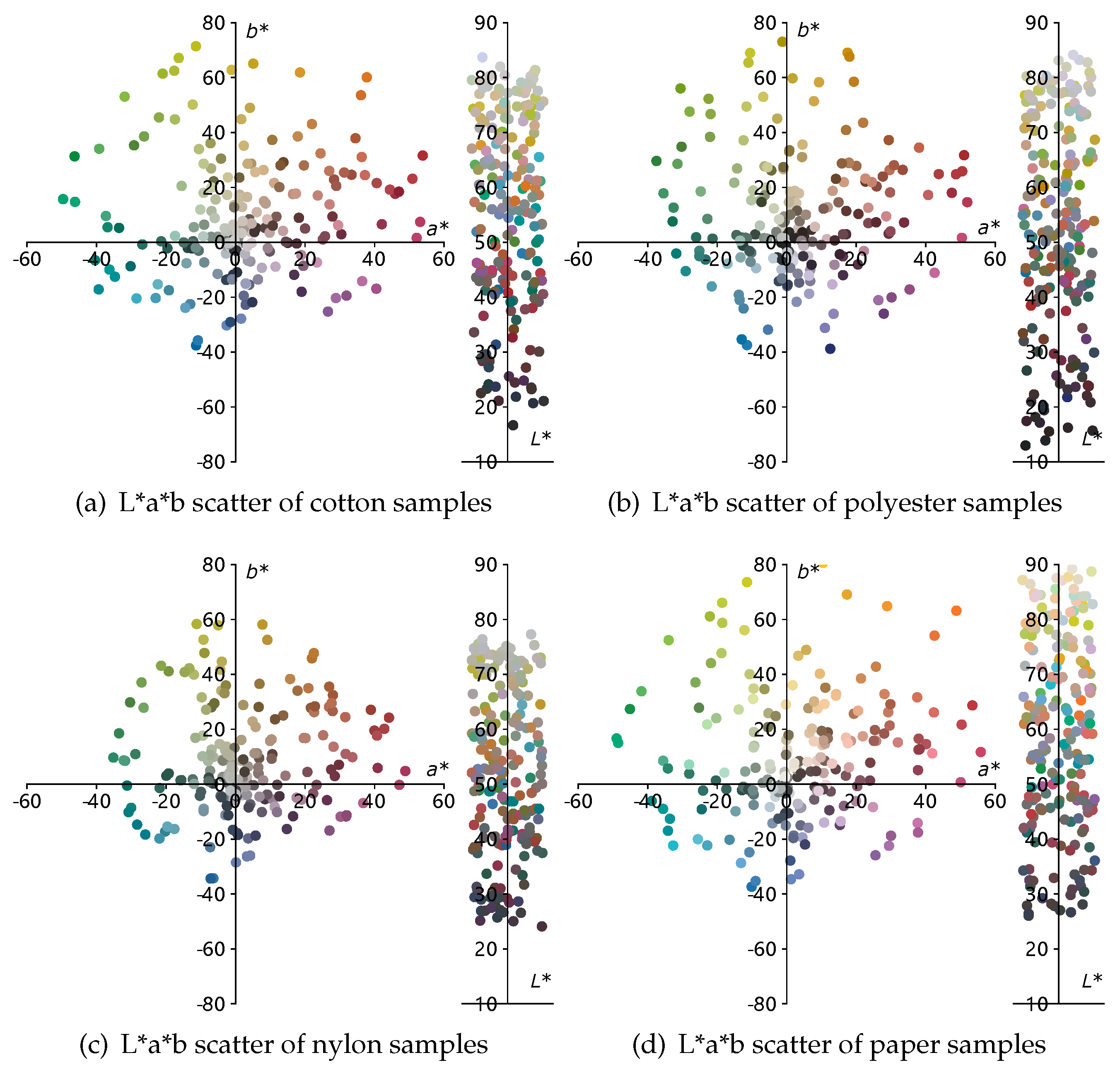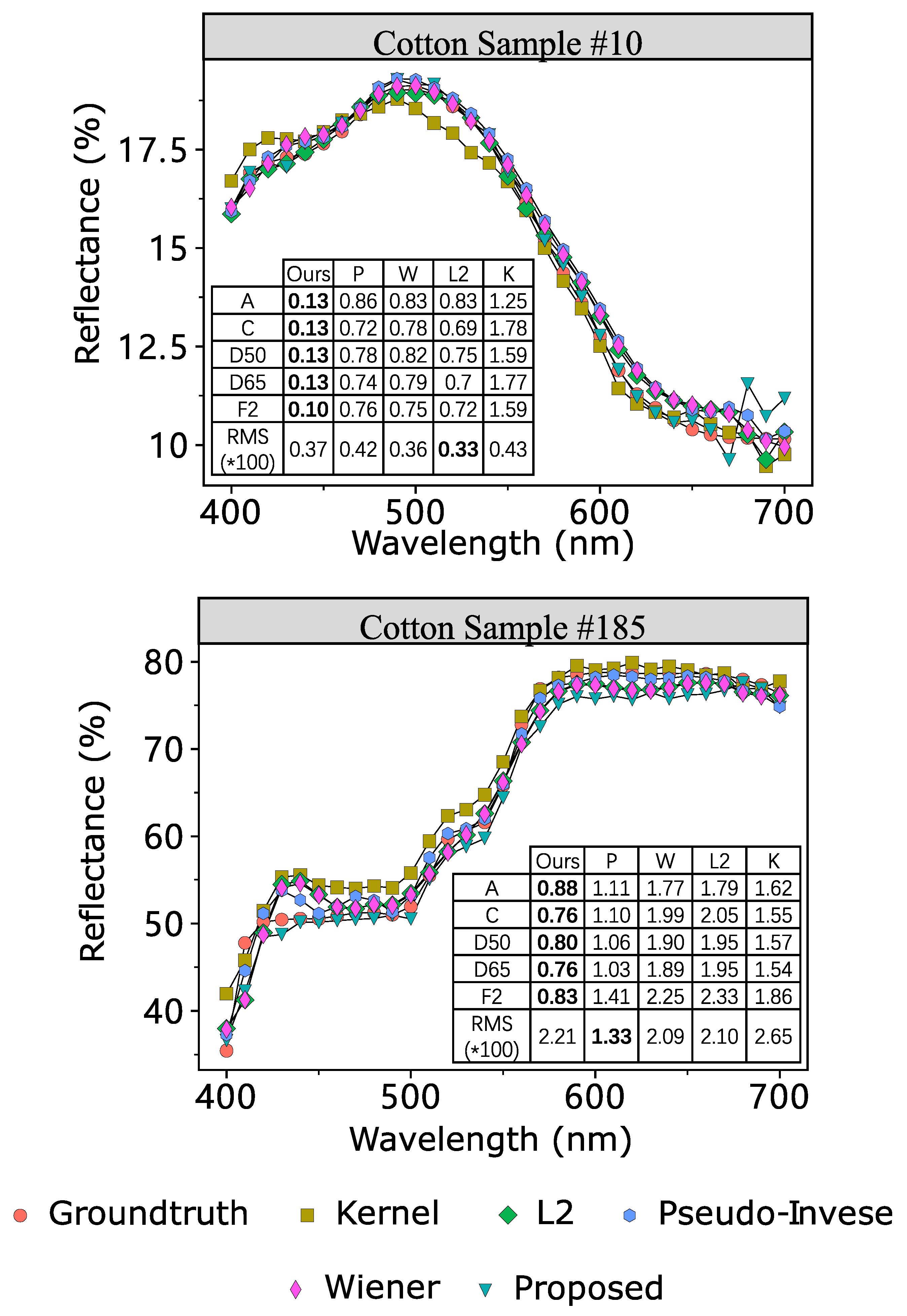Improving Generalizability of Spectral Reflectance Reconstruction Using L1-Norm Penalization
Abstract
1. Introduction
2. Formulation of Multispectral Imaging
3. Preliminaries
3.1. Least-Square Estimation (Pseudo-Inverse) and Ridge Regression (L2-Norm Penalization)
3.2. Wiener Estimation
3.3. Kernel Method
4. Proposed Method
5. Experiments and Results
5.1. Data Preparation
5.2. Evaluation Metric
5.3. Super-Parameter Estimation
5.4. Results
5.5. Time Analysis
5.6. Comparison with RGB-Based Methods
6. Discussion
6.1. Overfitting Problem
6.2. Sparsity Characteristic
6.3. Material Dependence
7. Conclusions and Future Work
Author Contributions
Funding
Institutional Review Board Statement
Informed Consent Statement
Data Availability Statement
Acknowledgments
Conflicts of Interest
References
- Lin, Y.T.; Finlayson, G.D. Exposure invariance in spectral reconstruction from rgb images. In Proceedings of the Color and Imaging Conference, Paris, France, 21–25 October 2019; Society for Imaging Science and Technology: Springfield, VA, USA, 2019; Volume 2019, pp. 284–289. [Google Scholar]
- Shen, H.L.; Cai, P.Q.; Shao, S.J.; Xin, J.H. Reflectance reconstruction for multispectral imaging by adaptive Wiener estimation. Opt. Express 2007, 15, 15545–15554. [Google Scholar] [CrossRef] [PubMed]
- Shen, H.L.; Xin, J.H.; Shao, S.J. Improved reflectance reconstruction for multispectral imaging by combining different techniques. Opt. Express 2007, 15, 5531–5536. [Google Scholar] [CrossRef] [PubMed]
- Shimano, N. Recovery of spectral reflectances of objects being imaged without prior knowledge. IEEE Trans. Image Process. 2006, 15, 1848–1856. [Google Scholar] [CrossRef] [PubMed]
- Murakami, Y.; Obi, T.; Yamaguchi, M.; Ohyama, N.; Komiya, Y. Spectral reflectance estimation from multi-band image using color chart. Opt. Commun. 2001, 188, 47–54. [Google Scholar] [CrossRef]
- Zhang, X.; Xu, H. Reconstructing spectral reflectance by dividing spectral space and extending the principal components in principal component analysis. JOSA A 2008, 25, 371–378. [Google Scholar] [CrossRef] [PubMed]
- Heikkinen, V.; Jetsu, T.; Parkkinen, J.; Hauta-Kasari, M.; Jaaskelainen, T.; Lee, S.D. Regularized learning framework in the estimation of reflectance spectra from camera responses. JOSA A 2007, 24, 2673–2683. [Google Scholar] [CrossRef] [PubMed]
- Heikkinen, V.; Lenz, R.; Jetsu, T.; Parkkinen, J.; Hauta-Kasari, M.; Jääskeläinen, T. Evaluation and unification of some methods for estimating reflectance spectra from RGB images. JOSA A 2008, 25, 2444–2458. [Google Scholar] [CrossRef] [PubMed]
- Luo, L.; Shen, H.L.; Shao, S.J.; Xin, J. Empirical model for matching spectrophotometric reflectance of yarn windings and multispectral imaging reflectance of single strands of yarns. JOSA A 2015, 32, 1459–1467. [Google Scholar] [CrossRef] [PubMed]
- Herzog, P.G.; Hill, B. Multispectral imaging and its applications in the textile industry and related fields. In Proceedings of the PICS, Rochester, NY, USA, 13 May 2003; pp. 258–263. [Google Scholar]
- Zhang, J.; Yao, P.; Wu, H.; Xin, J.H. Automatic color pattern recognition of multispectral printed fabric images. J. Intell. Manuf. 2022, 1–17. [Google Scholar] [CrossRef]
- Jiang, J.; Gu, J. Recovering spectral reflectance under commonly available lighting conditions. In Proceedings of the Computer Vision and Pattern Recognition Workshops (CVPRW), 2012 IEEE Computer Society Conference, Providence, RI, USA, 16–21 June 2012; pp. 1–8. [Google Scholar]
- Hardeberg, J.Y.; Schmitt, F.J.; Brettel, H. Multispectral color image capture using a liquid crystal tunable filter. Opt. Eng. 2002, 41, 2532–2549. [Google Scholar]
- Mosny, M.; Funt, B. Multispectral colour constancy. In Proceedings of the Color and Imaging Conference, Scottsdale, Arizona, 6–10 November 2006; Society for Imaging Science and Technology: Springfield, VA, USA, 2006; Volume 2006, pp. 309–313. [Google Scholar]
- Hardeberg, J.Y. Acquisition and Reproduction of Color Images: Colorimetric and Multispectral Approaches; Universal-Publishers: Irvine, CA, USA, 2001. [Google Scholar]
- Shen, H.L.; Xin, J.H. Spectral characterization of a color scanner based on optimized adaptive estimation. JOSA A 2006, 23, 1566–1569. [Google Scholar] [CrossRef] [PubMed]
- Nguyen, R.M.; Prasad, D.K.; Brown, M.S. Training-based spectral reconstruction from a single RGB image. In Proceedings of the European Conference on Computer Vision, Zurich, Switzerland, 6–12 September 2014; Springer: Berlin/Heidelberg, Germany, 2014; pp. 186–201. [Google Scholar]
- Connah, D.R.; Hardeberg, J.Y. Spectral recovery using polynomial models. In Proceedings of the Color Imaging X: Processing, Hardcopy, and Applications, San Jose, CA, USA, 17 January 2005; International Society for Optics and Photonics: Bellingham, WA, USA, 2005; Volume 5667, pp. 65–75. [Google Scholar]
- Shi, Z.; Chen, C.; Xiong, Z.; Liu, D.; Wu, F. Hscnn+: Advanced cnn-based hyperspectral recovery from rgb images. In Proceedings of the IEEE Conference on Computer Vision and Pattern Recognition Workshops, Salt Lake City, UT, USA, 18–22 June 2018; pp. 939–947. [Google Scholar]
- Akhtar, N.; Mian, A. Hyperspectral recovery from rgb images using gaussian processes. IEEE Trans. Pattern Anal. Mach. Intell. 2018, 42, 100–113. [Google Scholar] [CrossRef] [PubMed]
- Zou, Z.; Shen, H.L.; Li, S.; Zhu, Y.; Xin, J.H. Lighting Deviation Correction for Integrating-Sphere Multispectral Imaging Systems. Sensors 2019, 19, 3501. [Google Scholar] [CrossRef] [PubMed]
- Boyd, S.; Parikh, N.; Chu, E.; Peleato, B.; Eckstein, J. Distributed optimization and statistical learning via the alternating direction method of multipliers. Found. Trends Mach. Learn. 2011, 3, 1–122. [Google Scholar] [CrossRef]
- Shen, H.L.; Zhang, H.G.; Xin, J.H.; Shao, S.J. Optimal selection of representative colors for spectral reflectance reconstruction in a multispectral imaging system. Appl. Opt. 2008, 47, 2494–2502. [Google Scholar] [CrossRef] [PubMed]
- Schanda, J. Colorimetry: Understanding the CIE System; John Wiley & Sons: Hoboken, NJ, USA, 2007. [Google Scholar]
- Westland, S.; Ripamonti, C.; Cheung, V. Computational Colour Science Using MATLAB; John Wiley & Sons: Hoboken, NJ, USA, 2012. [Google Scholar]
- Lin, Y.T.; Finlayson, G.D. On the Optimization of Regression-Based Spectral Reconstruction. Sensors 2021, 21, 5586. [Google Scholar] [CrossRef] [PubMed]
- Bishop, C.M. Pattern Recognition and Machine Learning; Springer: Berlin/Heidelberg, Germany, 2006. [Google Scholar]
- Shiradkar, R.; Shen, L.; Landon, G.; Heng Ong, S.; Tan, P. A new perspective on material classification and ink identification. In Proceedings of the IEEE Conference on Computer Vision and Pattern Recognition, Columbus, OH, USA, 23–28 June 2014; pp. 2267–2274. [Google Scholar]











| Cotton | Nylon | Polyester | Paper | |
|---|---|---|---|---|
| 0.006 | 0.008 | 0.007 | 0.006 | |
| 0.074 | 0.082 | 0.078 | 0.077 | |
| 0.005 | 0.003 | 0.002 | 0.006 |
| Proposed | L2 | Psudo-Inverse | Wiener | Kernal | |
|---|---|---|---|---|---|
| Training (20 times) | 1759 | 4 | 4 | 1878 | 6143 |
| Testing (10,000 times) | 2232 | 2230 | 2231 | 1473 | 6,587,500 |
| Polynomial | RBF | Gaussian Process | |
|---|---|---|---|
| 1.80 | 1.56 | 2.18 |
| Mean D65 E | Mean F2 E | KL Diversity | |
|---|---|---|---|
| Paper | 1.0287 | 1.1783 | 1.5252 |
| Polyester | 0.8913 | 0.8189 | 0.1468 |
| Nylon | 1.0013 | 1.0742 | 0.281 |
| Cotton | 0.8386 | 0.9897 | 0.0747 |
Disclaimer/Publisher’s Note: The statements, opinions and data contained in all publications are solely those of the individual author(s) and contributor(s) and not of MDPI and/or the editor(s). MDPI and/or the editor(s) disclaim responsibility for any injury to people or property resulting from any ideas, methods, instructions or products referred to in the content. |
© 2023 by the authors. Licensee MDPI, Basel, Switzerland. This article is an open access article distributed under the terms and conditions of the Creative Commons Attribution (CC BY) license (https://creativecommons.org/licenses/by/4.0/).
Share and Cite
Yao, P.; Wu, H.; Xin, J.H. Improving Generalizability of Spectral Reflectance Reconstruction Using L1-Norm Penalization. Sensors 2023, 23, 689. https://doi.org/10.3390/s23020689
Yao P, Wu H, Xin JH. Improving Generalizability of Spectral Reflectance Reconstruction Using L1-Norm Penalization. Sensors. 2023; 23(2):689. https://doi.org/10.3390/s23020689
Chicago/Turabian StyleYao, Pengpeng, Hochung Wu, and John H. Xin. 2023. "Improving Generalizability of Spectral Reflectance Reconstruction Using L1-Norm Penalization" Sensors 23, no. 2: 689. https://doi.org/10.3390/s23020689
APA StyleYao, P., Wu, H., & Xin, J. H. (2023). Improving Generalizability of Spectral Reflectance Reconstruction Using L1-Norm Penalization. Sensors, 23(2), 689. https://doi.org/10.3390/s23020689






